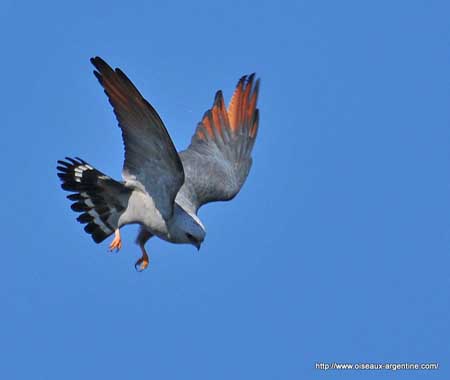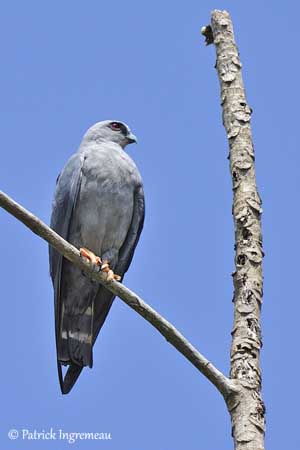
Plumbeous Kite
Ictinia plumbea
Accipitriforme Order – Accipitridae Family
BIOMETRICS :
Length : 33-37 cm
Wingspan : 84-94 cm
Weight : 190-280 g
DESCRIPTION:
Plumbeous Kite resembles in shape to Mississippi Kite, but with shorter tail. Both species are very similar.
DIET:
Plumbeous Kite feeds mainly on large insects. It also consumes smaller items such as flying termites. Insects are caught in the feet while flying or from a perch by snatching. Plumbeous Kite occasionally adds snails and small vertebrates, frogs and lizards.
PROTECTION / THREATS / STATUS:
Plumbeous Kite as wide range and habitat, and it is relatively common. This species is evaluated as Least Concern.
Fr: Milan bleuâtre
All : Schwebeweih
Esp : Elanio Plomizo
Ital : Ittinia plumbea
Nd : Donkergrijze Wouw
Russe : Сизый коршун
Photographers:
Patrick Ingremeau
TAMANDUA
Philippe and Aline Wolfer
OISEAUX D'ARGENTINE
Text by Nicole Bouglouan
Sources:
HANDBOOK OF THE BIRDS OF THE WORLD Vol 2 by Josep del Hoyo-Andrew Elliot-Jordi Sargatal - Lynx Edicions - ISBN: 8487334156
A GUIDE TO THE BIRDS OF MEXICO AND NORTHERN CENTRAL AMERICA by Steve N. G. Howell, Sophie Webb - Oxford University Press - ISBN: 0198540124
A GUIDE TO THE BIRDS OF COLOMBIA by Steven L. Hilty and William L. Brown
Princeton University Press – ISBN 069108372X
The Hawk Conservancy Trust (Hilary Smith)
Wikipedia (Wikipedia, The Free Encyclopedia)
SORA Searchable Ornithological Research Archive (Blair O. Wolf)
Adult male has slaty-grey plumage overall. Upperparts are mostly darker, nearly black. On the long, pointed wings, flight feathers are blackish, but inner webs of the outer primary coverts are rufous.
Underparts are slaty-grey. Under wings show rufous flash in primary coverts. Tail is blackish with two relatively narrow white bands.
Head is slaty-grey, slightly paler than body. Hooked bill is black with grey cere. Eyes are red. Lores are black. Legs and feet are orange-yellow.
Both sexes are similar.
BEHAVIOUR:
Plumbeous Kite feeds mainly on large flying insects, but most of them are captured on the wing and with talons. It seizes large insect in the feet, and eats it while flying. It also can take them from foliage. When hunting in flight, Plumbeous Kite can climb to seize an insect above, or dive and pursue it in shallow swoop.
This species is not very gregarious, but Plumbeous Kite migrates in flocks of 40 birds and more. They can fly widely separated higher in the air, but they often move just at tree-top level.
Plumbeous Kite often mates very soon after arrival at breeding grounds. Courtship displays seem to be absent. They start nesting as soon as they arrive.
FLIGHT:
Plumbeous Kite is highly aerial, and it spends most of its time in the air. It soars and glides, while it catches insects on the wing. When it is soaring, it has flattish wings with wing tips slightly higher, and tail slightly spread. It performs deep and easy wing beats.

Immature has grey upperparts, streaked with white. Underparts are whitish, streaked with grey-brown. It lacks the rufous wing patch below, but it has some rufous tinge on primaries. Head is whitish, densely streaked with blackish. We can see an indistinct white supercilium. Bill is black with yellow cere. Eyes are pale brown. Legs and feet are yellowish.
Young reaches adult plumage at about two to three years of age.
VOICE: SOUNDS BY XENO-CANTO
Plumbeous Kite is mostly silent. It sometimes utters shrill, thin whistles “si-yoo” or “siseeeoo”. These high-pitched calls are usually given when mates meet at nest. They can repeat these calls two or three times.
HABITAT:
Plumbeous Kite lives in wet evergreen or mixed forests and edges, up to 1700 metres of elevation. It is often seen near water and in mangroves.
RANGE:
Plumbeous Kite breeds from eastern Mexico, through Central America to Peru, Bolivia and Argentina, and also in Trinidad.
Birds of north and south areas of the range migrate, moving to tropical South America in winter.
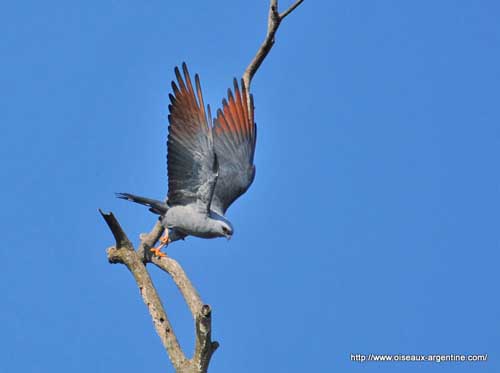
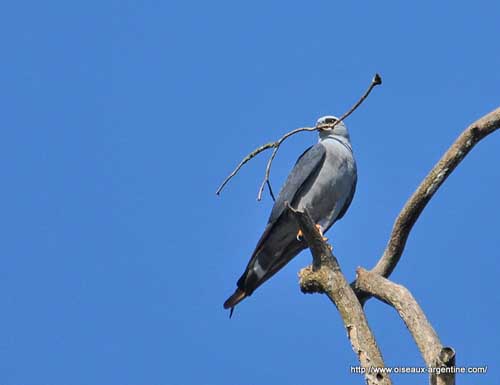
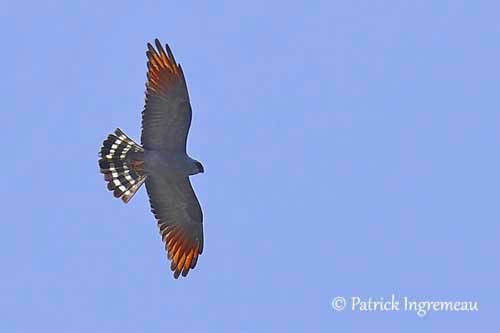
REPRODUCTION:
Breeding season starts in March, and young fledge in May or June.
Nest-site is in forest openings such as narrow roadways or large clearings. Nest is situated in live isolated tree, or emerging above the forest, and can be high in tree, between 13 and 30 metres above the ground.
It is often built in fork by both adults. It is made with dry sticks, and interior is lined with green leaves. Nest is built by both adults. Green vegetation is often added throughout incubation period. Plumbeous Kite may nest in the same nest or site, year after year.
The female usually lays one single white or pale bluish egg, sometimes two. Incubation lasts about 32 to 33 days shared by both parents, taking turns regularly throughout the day. When at nest, the adult incubates, but also stands and preens, stretches, rolls and shades the eggs.
At hatching, chicks are covered with white down. They have dark eyes, black bill and yellow cere. They are fed with insects.
During nesting period, Plumbeous Kite may be aggressive towards some bird’s species such as toucans and vultures.
Young fledge about 38 days after hatching.
